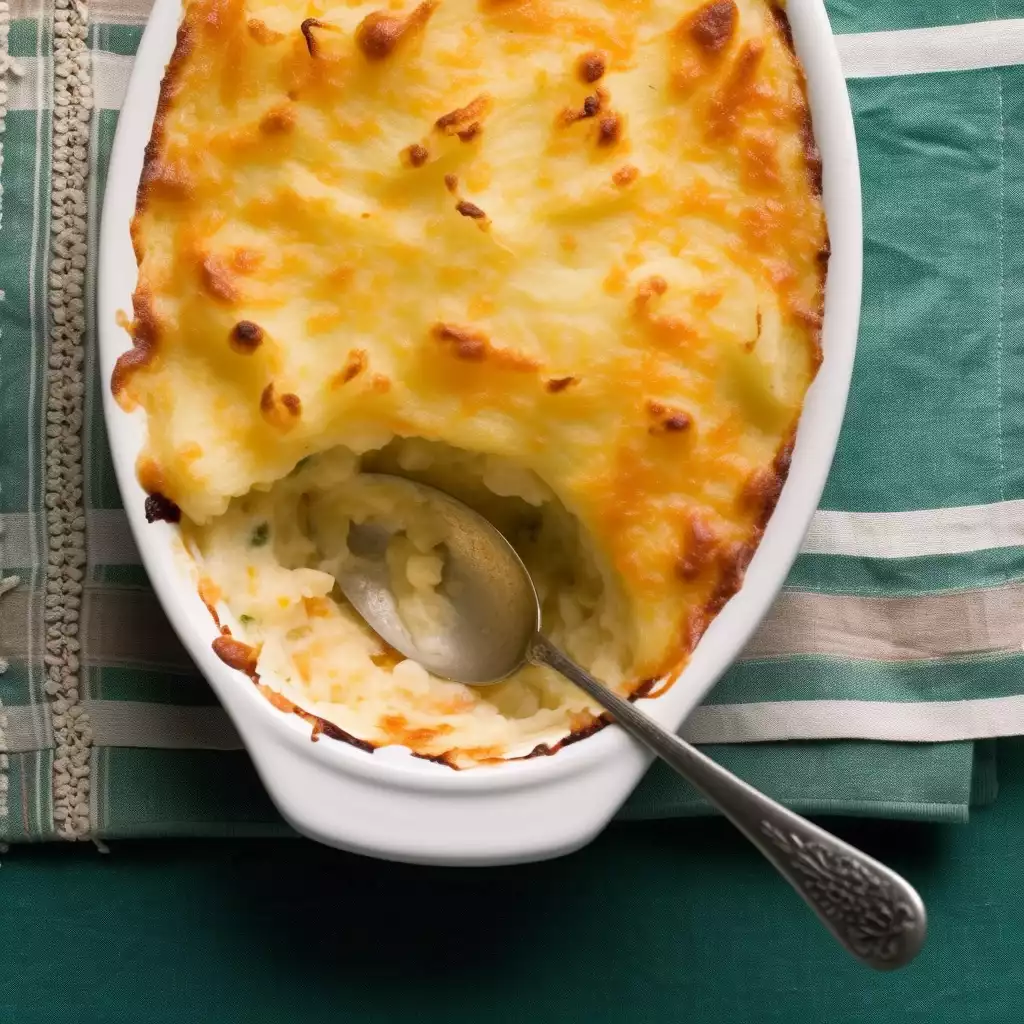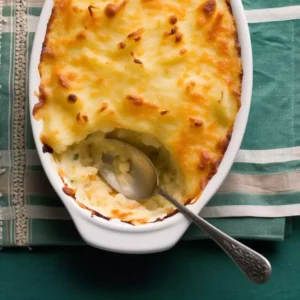
In the realm of comforting, hearty dishes, the Potato & Cauliflower Gratin reigns supreme. This dish combines the earthy richness of potatoes with the subtle nuttiness of cauliflower, enveloped in a creamy, cheesy embrace.
Originating from the heart of Europe, gratins have graced tables for centuries, evolving from humble peasant fare to beloved family favorites.
While the concept of layering thinly sliced potatoes with cheese and cream is simple, the execution of a perfect gratin requires a delicate balance of flavors and textures.
This recipe marries the starchy goodness of Russet potatoes with the delicate florets of cauliflower, creating a symphony of flavors in each creamy bite.
Crafting this gratin is a labor of love, requiring patience and attention to detail. From boiling the potatoes to tender perfection to creating a velvety cauliflower puree, each step contributes to the harmonious union of ingredients.
Whether served as a side dish or starring as the main event, Potato & Cauliflower Gratin is sure to warm hearts and satisfy cravings with its indulgent flavors and comforting aroma.
Expert Tip: Don’t skip the step of boiling the cauliflower before pureeing it. This ensures that it becomes tender enough to blend into a smooth puree, resulting in a creamy and velvety texture for the gratin.
Potatoes Russet: Potatoes form the hearty base of this gratin, providing a comforting starchiness that pairs perfectly with the creamy texture.
Salt: Essential for seasoning each component of the dish, salt enhances the natural flavors of the potatoes and cauliflower.
Milk: Both in the potato mash and cauliflower puree, milk adds creaminess and richness to the gratin, elevating its texture and flavor.
Butter Unsalted: Butter contributes to the lusciousness of the dish, providing richness and depth of flavor as it melts into the potatoes and cauliflower.
Italian Fontina or Gruyère: These cheeses lend their distinctive flavors and meltability, creating a gooey, cheesy layer that binds the gratin together.
Black Pepper: Adding a subtle warmth and depth, black pepper complements the creamy richness of the gratin.
Cauliflower: Cauliflower brings a lightness and slight sweetness to the dish, balancing the richness of the potatoes and cheese with its delicate flavor.
Garlic: Infusing the cauliflower puree with aromatic complexity, garlic adds depth of flavor and warmth to the gratin.
Parmesan Cheese: Finely grated Parmesan cheese adds a savory, umami-rich layer to the gratin, forming a golden crust that delights the senses.
Expert Tip: To add extra flavor, try infusing the milk with herbs or spices such as thyme, rosemary, or nutmeg before adding it to the potatoes and cauliflower.
Serve the Potato & Cauliflower Gratin as a hearty side dish alongside roasted meats such as chicken, beef, or pork. Its creamy texture and rich flavors complement the savory notes of roasted proteins, creating a satisfying meal.
For a vegetarian option, pair the gratin with a fresh green salad dressed with a light vinaigrette. The crispness of the salad provides a refreshing contrast to the indulgent gratin, making for a well-rounded and satisfying meal.
To elevate the gratin to a main course, serve it alongside steamed or roasted vegetables such as broccoli, carrots, or green beans. The combination of textures and flavors creates a balanced and satisfying plate that is sure to please vegetarians and omnivores alike.
For a cozy brunch or lunch option, serve the gratin with a side of crusty bread and a selection of pickles or chutneys. The combination of warm, creamy gratin and crusty bread is a comforting and satisfying choice for a leisurely meal.
Expert Tip: For a smoother texture, consider using a potato ricer or food mill to mash the potatoes before combining them with the other ingredients.
Yes, you can experiment with different potato varieties, but keep in mind that Russet potatoes are preferred for their high starch content, which contributes to the creamy texture of the gratin. Varieties like Yukon Gold can also work well due to their creamy texture, but avoid waxy potatoes like red potatoes, as they may not mash as smoothly.
Absolutely! You can prepare the gratin up to the point of baking, then cover and refrigerate it for up to one day. When you’re ready to bake, simply bring it to room temperature while the oven preheats, then proceed with baking as directed in the recipe.
While it’s best enjoyed fresh, you can freeze leftover gratin for up to 1-2 months. To freeze, let the gratin cool completely, then wrap it tightly in plastic wrap or aluminum foil and place it in an airtight container. When ready to enjoy, thaw overnight in the refrigerator before reheating in the oven until warmed through.
To achieve a crispy top on the gratin, make sure to broil it for the last few minutes of baking. This will help to brown the cheese and create a deliciously crispy crust. Just be sure to keep an eye on it to prevent burning.
Absolutely! Feel free to get creative and customize this recipe to suit your taste preferences. You can add ingredients like bacon, caramelized onions, fresh herbs, or even different types of cheese to create your own unique twist on the classic gratin recipe.
Here are some more recipes for you to enjoy! If you my recipes don’t forget to rate and leave a comment.
If you have any recipe suggestions, please do not hesitate to ask me. A great way to stay in contact with me is through Instagram, Facebook, Twitter and YouTube. Don’t forget to tag me @CookwithNabeela in your recipe photos!

Subscribe now to receive my latest recipes directly in your inbox. Stay up-to-date and never miss out!

I love to cook! I want to share with you my favourite, delicious family-friendly recipes. I want to inspire you to create fantastic food for your family every day.
Latest comments (2)
Can I skip Italian Fontina or Gruyère?
Yes, you can exclude this if you want to or you can replace it with different cheese of your liking.